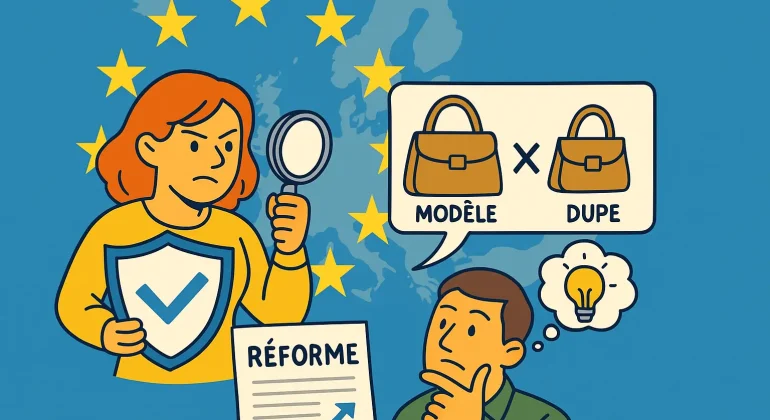Sommaire
Introduction
The proliferation of dupes imitation products that mimic the aesthetics of branded goods has become a major concern for the fashion, luxury, cosmetics, and electronics industries. These items, widely sold online through marketplaces and social media, not only capture part of the market but also dilute brand value and erode consumer trust.
Fighting dupes today requires more than traditional anti-counterfeiting actions. It calls for a comprehensive strategy combining IP registrations, digital monitoring, swift enforcement measures, and an intelligent use of the new EU design reform, which modernizes protection and enforcement tools.
Understanding dupes: nature, risks, and challenges
A dupe is an imitation product that replicates the appearance or style of an original item without being an exact counterfeit. Unlike traditional counterfeits, dupes often operate in a gray zone:
- Mimicking the visual identity of the original (shape, patterns, packaging), sometimes with slight modifications to avoid direct legal exposure;
- Leveraging brand awareness by presenting themselves as “inspired by” the original, particularly through viral content on TikTok and Instagram;
- Undermining brand value by associating inferior quality with the original product in the eyes of consumers.
Dupes are particularly prevalent in:
- Fashion and accessories (bags, sneakers, jewelry);
- Cosmetics and perfumes (look-alike bottles and packaging);
- Consumer electronics (earbuds, smartwatches, branded-style accessories).
They represent a commercial, reputational, and sometimes safety risk, especially in sectors where consumer trust is critical.
Deploying an effective anti-dupe strategy
A robust anti-dupe plan relies on three pillars: legal protection, market monitoring, and rapid enforcement.
2.1 Securing intellectual property rights
- Register all designs with the EUIPO and/or national offices for significant creations;
- File 3D or semi-figurative trademarks, especially for iconic packaging;
- Document originality through dated prototypes, photos, and digital proof to support enforcement actions.
Without properly secured rights, fighting dupes becomes significantly harder.
2.2 Implementing proactive and multi-channel monitoring
Modern dupes spread across digital ecosystems:
- Marketplaces like Amazon, AliExpress, and Vinted;
- Social media such as TikTok, Instagram, and Pinterest, which accelerate trends;
- Search engines and sponsored ads, where dupes may appear before the original.
An efficient monitoring system combines:
- Automated detection tools (reverse image search, web crawlers);
- Customs alerts to intercept suspicious imports;
- Tracking of influencers promoting look-alike products.
2.3 Using all enforcement tools
Once a dupe is identified, brands can act through:
- Online takedowns
- Using DMCA or platform-specific IP complaint tools;
- Rapid removal is often possible if designs are properly registered.
- Customs interventions
- Filing a Customs Action Request (AFA) enables seizure of infringing goods at the border.
- Targeted legal actions
- Civil (design or trademark infringement, unfair competition) to obtain injunctions and damages;
- Criminal, where organized or large-scale dupe networks are involved.
- Brand communication
- Educating consumers and distributors reduces tolerance for dupes and mitigates reputational risk.
Leveraging the EU design reform
The 2025 EU design reform modernizes protection mechanisms and directly strengthens anti-dupe strategies.
3.1 Strengthened protection adapted to digital markets
- Clearer definitions of “design” and “complex product”;
- Full protection for digital and 3D designs;
- Faster and cheaper online registration processes.
3.2 Simplified cross-border enforcement
- Single actions can now cover multiple EU Member States;
- Harmonized, accelerated procedures make it easier to block dupes before they saturate the market.
3.3 Synergy between anti-dupe measures and the reform
By combining:
- Systematic design and trademark registrations,
- Active digital surveillance,
- Use of EU-wide enforcement tools,
companies can deploy a cohesive, effective response to the growing dupe phenomenon.
Conclusion
Dupes are a persistent and fast-evolving threat to brand value and creative industries. Through a combination of proactive IP management, market monitoring, rapid enforcement, and the strategic use of the EU design reform, businesses can protect their creations, maintain market integrity, and strengthen their competitive position.
Dreyfus Law firm assists its clients in managing complex intellectual property cases, offering personalized advice and comprehensive operational support for the complete protection of intellectual property.
Dreyfus Law firm is partnered with a global network of lawyers specializing in intellectual property.
Nathalie Dreyfus with the assistance of the entire Dreyfus team.
FAQ
1. What is a dupe?
An imitation product that mimics a brand’s style without being an exact copy.
2. Why is it a problem?
Dupes devalue the brand, create confusion, and harm its reputation.
3. How can you protect your creations?
Register your designs, document originality, and monitor the market.
4. How does the EU design reform help?
It simplifies filings, strengthens protection, and enables faster EU-wide actions.
5. What are the key steps to fight dupes?
Register, monitor, and act quickly (takedown, customs, legal actions).


